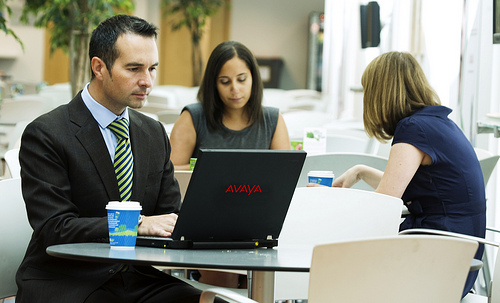
For some people an office is still a physical place of work such as a fully equipped room, a cubicle or a desk in a fixed location. But for more and more people, the office is their digital handheld device, which goes with them wherever they go. They feel it’s no longer necessary – or in some cases they no longer have the opportunity – to have a specific place of work. And many no longer have a hardcopy planner, paper documents and files, a landline telephone and regular face-to-face interactions with others.
For these people, work is no longer a place to go to, but a state of mind. There is no limit to the length of a workday. The 9-to-5 day is being replaced by the 24-hour day. There is no beginning or end to work – just as there is no single location where the bulk of the work gets done.
In days gone by, when we all had structure in our lives, we scheduled breaks, lunch hours, and time to rejuvenate. When he did work at home, it was said to be “on our own time.” Normally, the time after 5 PM was spent at home with family and friends or going to a ball game or for a walk in the park or kicking a soccer ball with the next-door neighbour’s kids.
And in spite of spending two thirds of our time away from the job, we managed to build successful businesses, drive nice cars, and maintain a decent level of productivity.
I’m not saying the old way of working was better, only different. We increased productivity in those days by taking time management seriously and utilizing most of the working portion of the days getting the important things done. This required that we set goals, establish policies and procedures, increase efficiency, focus on priorities and learn when to say no. We had to overcome both procrastination and perfectionism, cooperate with our coworkers, and generate new ideas through team effort. We did not work in isolation. The result was quite astounding considering that we had limited technology and limited time.
Just think what today’s workers could accomplish with today’s technology, flexibility and unlimited access to information if they were also able to add structure to their lives, control the technology, and work efficiently in this ever changing environment.
Different times require different strategies. So the next few articles may apply more to those millions of mobile workers who either work on the move or at least partially work from home.
The June, 2016 issue of Mindful magazine mentioned that an estimated 105 million people will be “mobile workers” by 2020, getting their work done with flexible office situations. And a U.S. Bureau of Labor Statistics survey found that 24% of all workers work at home at least part of the day.
How does one stay productive in an environment that may change from week to week or even day-to-day? Well to start, we can apply those time-tested strategies that will still work regardless of the environment. These would include setting specific goals for the week, developing personal policies or guidelines, planning our week, and making specific commitments as opposed to simply working from “to do” lists. Many of these strategies have been lost as we scurry to keep up with the quickening pace of life.
We have been playing “rushing” roulette, gambling that the next email opened might not be a waste of time. So quickly check your email in the morning if you feel less stressed doing so, and then limit yourself to 90 minute intervals throughout the rest of the day.
You could add additional structure to your week by selecting at least one high-performance work area where you are more self-disciplined and focused, and spend at least part of each day there.
Your high-performance area is a place where you have the most energy and get your best ideas. This could be a coffee shop or a room at home or a table on the patio. For instance, I like to spend a good hour and a half working on priority tasks at a coffee shop immediately following a brief walk. Being a morning person, I am most mentally alert and creative at that time. Also the coffee shop is well lit with natural lighting and a soothing hum that tends to mask noises and encourage creativity. This is not meant to be a coffee break but rather a work break – free from text messages, email or phone calls. So turn off or silence your devices while working in your high-performance area..
Once we add structure to our lives, most of the other strategies become easier to apply. I suggest the following order:
- Set boundaries for your workday. It doesn’t have to be 9 to 5 but be specific. For many people this currently varies greatly from day-to-day – even extending into weekends, family time and vacation time. Structure is essential because if you have 24 hours to complete your priority tasks, it may take 24 hours to do so. So define your workday.
- After deciding in advance what your workday will be, roughly allocate time for the important projects, tasks and activities that are currently on your plate. This requires the use of a planner or other tool that matches your style. I prefer a hardcopy planner in which I block of times for the important activities – both discrete tasks and ongoing projects. Block out project times at least a week or two in advance.
- Develop routines and habits for those ongoing important repetitive activities that you have identified. This conserves energy, saves time, and makes it easier to get things done on time.
These steps, which seem to represent old ways of doing things, may seem impossible in today’s environment. But I hope to prove to you in future blog articles that it is possible if you make a few tweaks to the way you currently do things.
Next blog article: A little self-discipline goes a long way.


Recent Comments